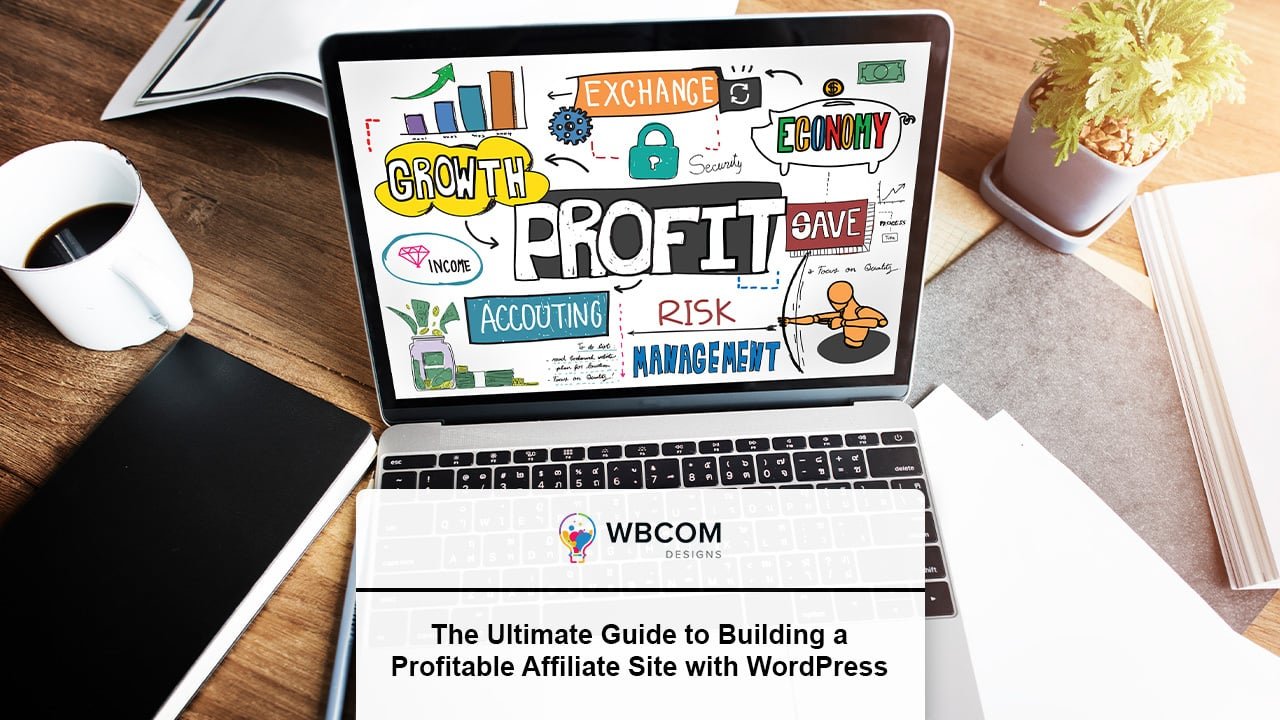Affiliate marketing has become a popular way to monetize websites, and WordPress provides a powerful platform for creating profitable affiliate sites. In this step-by-step guide, we will walk you through the process of building an affiliate site using WordPress. From choosing a niche to selecting affiliate programs, optimizing content, and driving traffic, we’ll cover all the essential steps to help you create a successful and profitable affiliate site.
Table of Contents
ToggleSelecting a Profitable Niche
Selecting a profitable niche is crucial for the success of your affiliate site. Here are some effective strategies for niche selection:
Market Research
Conduct thorough market research to identify high-demand and earning potential niches. Look for niches that align with your interests, passions, and expertise. Use keyword research tools to identify search volume and competition for potential niches. Look for niches with a healthy balance of demand and manageable competition.
Competitor Analysis
Analyze competitors within your potential niches. Identify successful affiliate sites and examine their strategies, content, and monetization methods. This analysis will help you understand the competition level and identify opportunities for differentiation and improvement.
Profitable Affiliate Programs
Look for affiliate programs that offer high commissions and align with your chosen niche. Research different affiliate networks and platforms to find programs that fit your niche’s products or services. Consider commission rates, cookie duration, product quality, and affiliate support.
Passion and Expertise
Choose a niche you are passionate about or have expertise in. This will make the process more enjoyable and enable you to create high-quality content and establish yourself as an authority in the niche. Your passion and knowledge will shine through your content and attract a more engaged audience.
Evergreen vs. Trending Niches
Consider the longevity of your chosen niche. Evergreen niches, such as health, fitness, and personal finance, have enduring demand and can provide consistent income over time. Trending niches, such as new technology or fashion trends, may offer higher short-term potential but can be more volatile. It’s a balance between long-term stability and short-term opportunities.
Target Audience
Understand your target audience within the niche. Identify their pain points, desires, and purchasing behavior. Ensure that your chosen niche has a sizable and accessible target audience that can generate consistent traffic and conversions.
Also Read: 15 WordPress Plugins to Create Content
Set up your WordPress site
The key steps to setting up your WordPress site for your affiliate marketing endeavor.
Purchase a Domain and Hosting:
Domain: Your domain name is the address of your website that people type in the browser URL bar to visit your website. It should be easy to pronounce, spell, and short. Consider using keywords related to your niche.
Hosting: This is where your website files are stored. Choosing a reliable web hosting company that guarantees at least 99.9% uptime is crucial. Some popular choices include Bluehost, SiteGround, and Kinsta. Some factors to consider when choosing your hosting include the price, customer service, and whether they offer a one-click WordPress install.
Install WordPress:
Most hosting providers offer a one-click WordPress installation. After you’ve signed up for a hosting account, you should be able to access your hosting dashboard. Look for the WordPress icon and follow the prompts for installation. During this process, you’ll need to create a username and password for your WordPress account.
Choose a Theme:
Themes dictate the overall design and appearance of your website. There are thousands of pre-made WordPress themes available for various niches. When choosing a theme, consider its aesthetic appeal, whether it fits your industry/niche, load speed, ease of customization, and mobile-responsive.
Install Plugins:
Plugins are like apps for your WordPress site, allowing you to add new features and functionalities—checkout plugins for your affiliate marketing website.
Also Read: The Principles of Community in Action: Creating a Welcoming Environment
Create Quality Content
Creating quality content is an essential part of building a good affiliate site. The primary aim of your content should be to provide value to your audience. This could be in the form of informative blog posts, comprehensive product reviews, step-by-step how-to guides, and more. Each piece of content you create should be thoughtfully crafted to address your target audience’s needs, interests, and concerns.
When creating content, ensure it is well-researched and accurate, as this helps build trust with your audience and improves your site’s ranking in search engine results. Focus on creating unique, engaging content that encourages your audience to share it and return for more. Use your content to subtly promote the products or services you’re affiliated with, but avoid being overly promotional, as this can turn off your audience.
Remember, consistent content creation is critical. Regularly updating your site with new, quality content can help attract and retain a loyal audience, increase your site’s visibility on search engines, and, ultimately, increase the likelihood of affiliate link clicks and conversions. It may take time and effort, but the rewards of quality content creation are well worth it in the long run.
Incorporate Affiliate Links
Incorporating affiliate links into your content is crucial to generating income from your affiliate site. When embedding these links, making their placement feel organic and contextually relevant is essential. Rather than forcing or overcrowding your content with links, insert them where they naturally fit. For instance, you can place affiliate links in your product reviews, tutorial articles, or resource pages.
The key is to be transparent and honest about using these links. Always provide genuine value to your readers and use affiliate links as a supplementary aspect of your content, not the focal point. Remember to include an affiliate disclosure on your site to inform readers that you may earn a commission for purchases made through your links. This disclosure is not only a best practice but is also legally required in many jurisdictions, such as the United States, under the Federal Trade Commission’s guidelines.
Lastly, consider using a link management tool like Pretty Links. This can help keep your links organized, track click-through rates, and make your links more user-friendly by shortening them or making them more readable. Remember, your ultimate goal is to create a trusting relationship with your audience, and being open about your affiliate links is a part of that process.
Drive Traffic to Your Site
Driving traffic to your site is critical in building a profitable affiliate site. There are several strategies you can use:
Search Engine Optimization (SEO)
This involves optimizing your website and its content to rank higher on search engine results pages (SERPs), increasing your visibility and organic traffic. This includes keyword research and optimization, creating quality content, using meta tags, creating SEO-friendly URLs, and building quality backlinks.
Social Media Marketing
Leverage platforms like Facebook, Instagram, Twitter, LinkedIn, and Pinterest to promote your content and attract more visitors. Each platform has its own unique user base and content preferences, so tailor your posts to each one. Engage with your followers, respond to comments, and follow your posting schedule.
Email Marketing
Build an email list by offering your website visitors something valuable in return for their email address, like a free eBook, a discount code, or access to exclusive content. Send regular newsletters with valuable content, and include your affiliate links where appropriate.
Paid Advertising
Pay-Per-Click (PPC) advertising, social media ads, and display ads. Google Ads and Facebook Ads are popular platforms for this. While this method involves an upfront investment, it can quickly drive a significant amount of traffic to your site.
Guest Blogging and Influencer Outreach
Collaborating with other bloggers or influencers in your niche can also help drive traffic. You could write guest posts for other websites or work with influencers to promote your content.
Content Syndication
This involves republishing your content on third-party websites or platforms. This can extend your content’s reach and attract new audiences.
Optimize for Conversions
Optimizing your website for conversions is vital to running a profitable affiliate site. This process involves making strategic changes to your site to increase the likelihood of visitors taking desired actions, such as clicking on affiliate links or signing up for your email list.
One helpful technique for conversion optimization is A/B testing, where you create two versions of a page or element and see which performs better. For instance, you might test two different call-to-action (CTA) buttons to see which one gets more clicks.
Heatmaps are another valuable tool for conversion optimization. They visually represent where users click, scroll, and spend time on your site, helping you understand what content or elements are attracting attention and which are being ignored.
Utilizing analytics tools like Google Analytics can provide insightful data about your audience’s behavior. Understanding your audience, where they’re coming from, and how they interact with your site can inform your conversion optimization strategies.
You can use these insights to make data-driven decisions about how to improve your site. For instance, if your analytics show that your site loads slowly, you might optimize your site’s speed, as a slow site can deter visitors and negatively impact your search engine ranking. If you find that users aren’t interacting with your CTA, you might redesign it or move it to a more prominent location on the page.
Monitor and Improve
Monitoring and improving your website is an ongoing process crucial for your affiliate site’s success. Regularly reviewing your site’s performance lets you understand what’s working well and what needs improvement. Tools like Google Analytics can provide invaluable insights into your site’s performance, such as traffic sources, user behavior, most viewed pages, and conversion rates.
By regularly analyzing this data, you can identify patterns and trends. For example, if you notice that a specific type of content or affiliate product is attracting more attention or generating more conversions, you might create more content or promote that product more heavily.
Conversely, if specific strategies aren’t working as well as expected, it’s essential to understand why and make necessary adjustments. For instance, if a specific page has a high bounce rate, you might need to improve the page’s content, design, or loading speed.
It’s also essential to monitor changes in user behavior, market trends, and search engine algorithms, as these can all impact your site’s performance. Keeping your site updated and adapting your strategies to these changes can help you stay competitive and maximize your affiliate earnings.
Diversify Your Income
Diversifying your income is a strategic move that can significantly contribute to the financial health of your affiliate business. Having multiple income streams increases your earning potential and provides a safety net in case one income stream falters. Once you’ve established a steady income from your initial affiliate marketing efforts, there are several ways you can diversify.
One option is to join additional affiliate programs. If you’re promoting products or services from one company, consider adding related products from different companies. However, ensure these additional products or services align with your niche and are valuable to your audience.
Another avenue for diversification is creating and selling your products or services. Depending on your niche, this could be anything from an ebook or online course to physical merchandise. This gives you more control over your income and can also help to establish you as an authority in your field.
Starting a second site is another way to diversify your income. If you’ve identified another niche with potential, creating a new affiliate site allows you to tap into a different market. But remember, managing multiple sites requires more time and effort, so ensure you’re ready for the commitment.
Exploring other monetization methods, like sponsored content or advertising, can provide additional income. Just ensure that any sponsored content or ads you feature are relevant to your audience and don’t detract from the user experience on your site.
Stay Updated
Staying updated with the latest trends in your niche and the affiliate marketing field is essential for your site’s sustained growth and competitiveness. The digital landscape is ever-evolving, with new trends, technologies, and consumer behaviors constantly emerging. By keeping up-to-date, you can adapt your strategies to these changes, ensuring that your site remains relevant and engaging to your audience.
In your niche, look out for new products, services, or topics of interest that could provide valuable content for your audience. Being one of the first to cover these topics or promote these products can give you an edge over the competition.
In affiliate marketing, keep an eye on new strategies, tools, and best practices. For example, changes to search engine algorithms could affect your SEO strategy or new social media platforms could offer new opportunities for promotion. Regularly reading industry blogs, attending webinars or conferences, and participating in online forums can help you stay informed.
Additionally, keep track of any changes to the terms of your affiliate programs. Companies may adjust their commission rates, payment terms, or product offerings, which could affect your earnings.
Conclusion On Building a Profitable Affiliate Site With WordPress
In conclusion, building a profitable affiliate site with WordPress requires a strategic approach and a commitment to ongoing learning and improvement. From choosing a relevant niche and setting up your WordPress site to creating quality content, optimizing for conversions, and monitoring your site’s performance, each step plays a crucial role in the success of your affiliate marketing efforts.
Once you’ve established a steady income stream, diversifying your income can provide financial stability and increase your earning potential. Meanwhile, staying updated with the latest niche trends and affiliate marketing trends can help you stay competitive and adapt your strategies to changing market conditions.
Building a successful affiliate site doesn’t happen overnight. It requires time, effort, and patience. But with perseverance, the right strategies, and a focus on providing value to your audience, you can build a profitable affiliate site with a substantial income stream. Continue learning, experimenting, and optimizing, and you’ll be well on your way to affiliate marketing success. Don’t forget to enjoy the journey as you build, grow, and monetize your site. Good luck!
Interesting Reads:
WordPress Plugins That Help In Doubling Your Website Traffic








